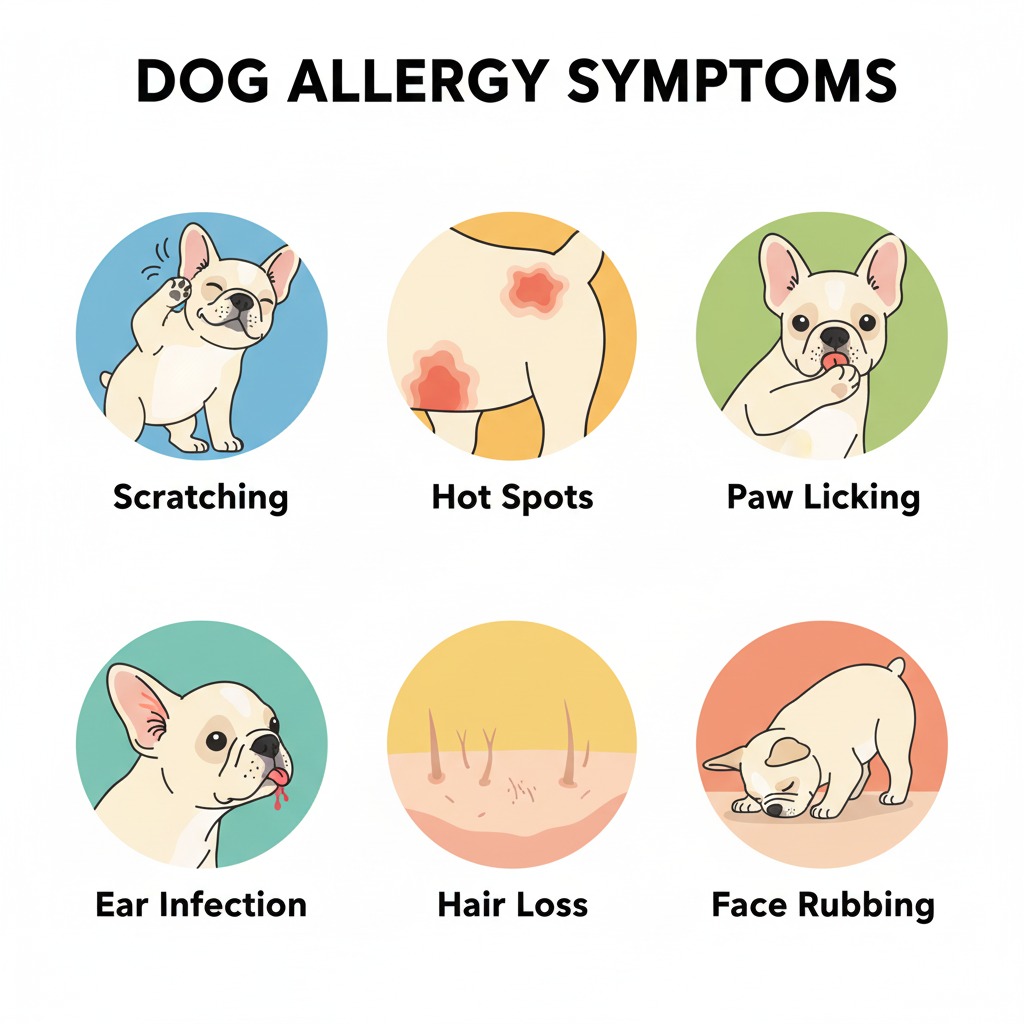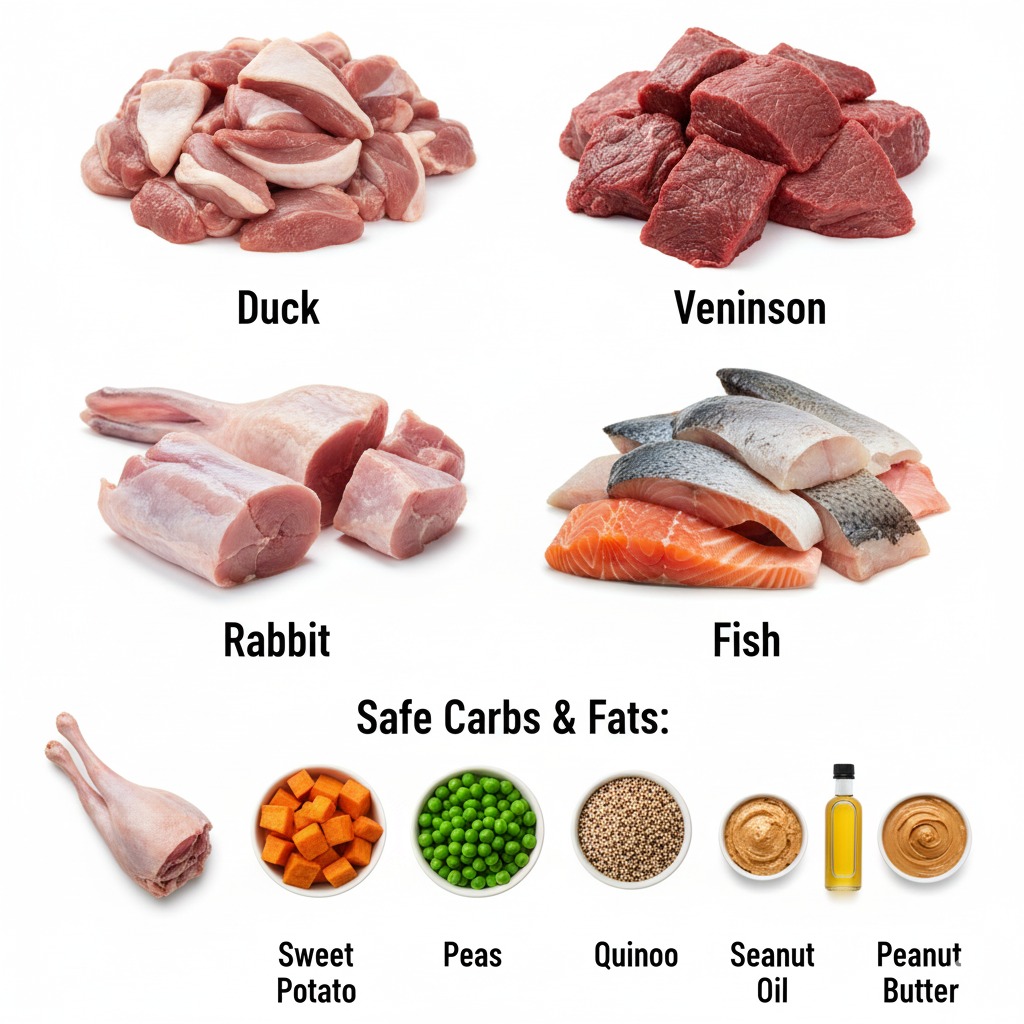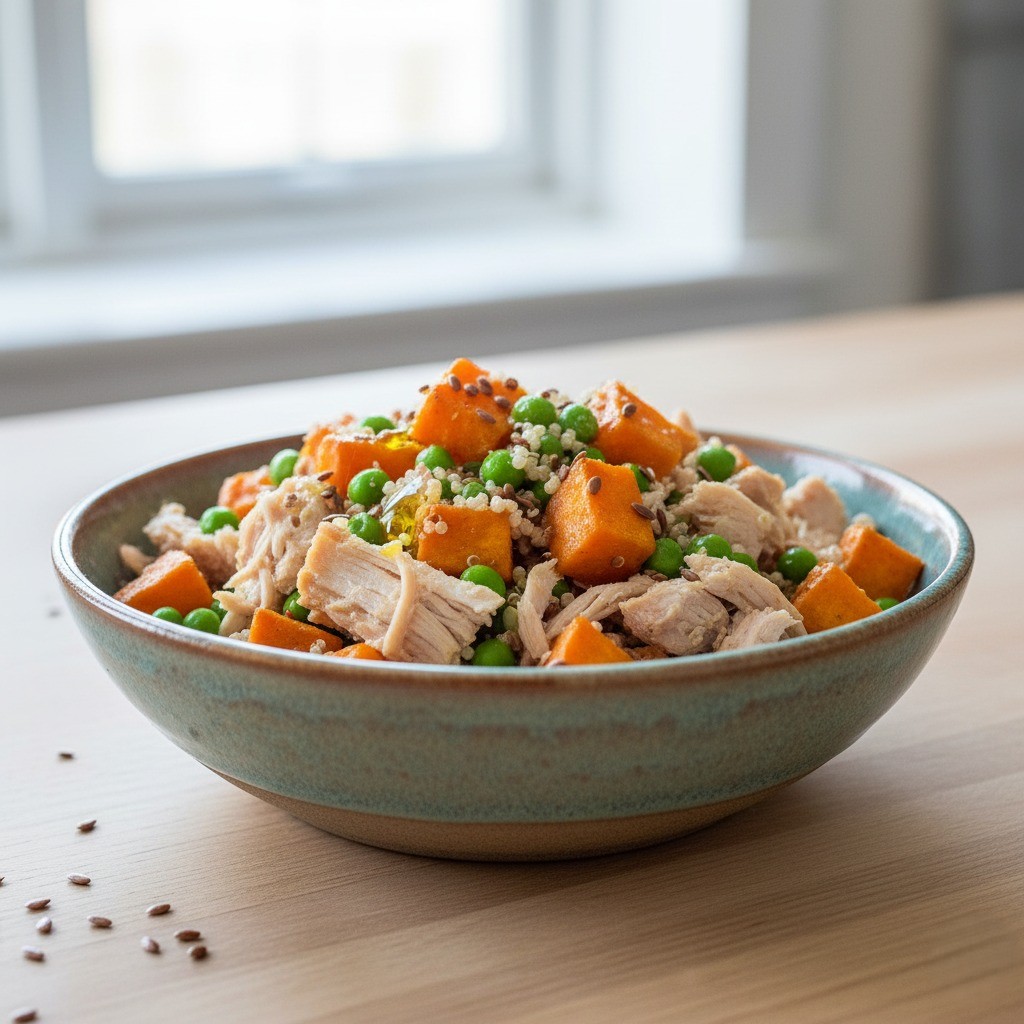Have you ever watched your furry friend scratch endlessly, only to feel helpless about how to provide relief? If your dog suffers from skin allergies, you’re not alone in this frustrating journey. Many pet owners discover that the solution lies not in expensive medications or specialized treatments, but right in their own kitchen.
Creating homemade food for dogs with skin allergies isn’t just a trend—it’s a game-changing approach that puts you in complete control of what goes into your dog’s bowl. When commercial dog foods fail to provide relief, turning to fresh, carefully selected ingredients can be the key to unlocking your pet’s comfort and happiness.
Understanding Canine Skin Allergies
Before diving into the kitchen, let’s get familiar with what we’re actually fighting against. Skin allergies in dogs are like that annoying friend who shows up uninvited—they’re persistent, uncomfortable, and seem to stick around longer than welcome.
Common Signs and Symptoms
Does your dog exhibit any of these telltale signs? Constant scratching, red and inflamed skin, hot spots, excessive licking of paws, ear infections, or even hair loss in certain areas. These symptoms often point toward food-related allergies that manifest through the skin.
Think of your dog’s skin as a window into their internal health. When something isn’t right on the inside, the outside often tells the story. Skin allergies can turn your once-happy pup into an uncomfortable, irritated companion who can’t seem to find relief no matter how much they scratch.

Types of Food Allergies in Dogs
Food allergies in dogs typically fall into two categories: true allergies and food intolerances. True allergies trigger an immune system response, while intolerances cause digestive upset that can manifest as skin problems. Both can make your dog miserable, but understanding the difference helps you tackle the root cause more effectively.
The most common culprits? Beef, dairy, wheat, chicken, eggs, corn, and soy. These ingredients appear in countless commercial dog foods, making it nearly impossible to pinpoint the exact trigger without careful elimination.
Why Choose Homemade Food for Allergic Dogs?
Making the switch to homemade food isn’t just about following the latest pet care trend—it’s about taking control of your dog’s health in a way that commercial foods simply can’t match
Benefits Over Commercial Dog Food
When you prepare your dog’s meals at home, you become the quality control manager. No more squinting at ingredient lists filled with unpronounceable chemicals or mysterious meat by-products. You know exactly what goes into every bite, and more importantly, what stays out.
Commercial dog foods often contain multiple protein sources, various grains, preservatives, and artificial additives that can trigger allergic reactions. Even foods labeled as “limited ingredient” might contain trace amounts of common allergens due to cross-contamination during manufacturing.
“When commercial dog foods fail to provide relief, switching to a trusted hypoallergenic dog food like Hill’s Prescription Diet z/d Skin/Food Sensitivities Dry Dog Food can be a game-changer.”
Control Over Ingredients.
Imagine having a magic wand that could eliminate every potential allergen from your dog’s diet. Homemade food is essentially that magic wand. You can create meals using novel proteins your dog has never encountered, eliminate suspected triggers completely, and introduce new ingredients one at a time to monitor reactions.
This level of control is particularly valuable during elimination diets, where you’re systematically removing and reintroducing ingredients to identify specific triggers. It’s like being a detective, but instead of solving crimes, you’re solving the mystery of your dog’s skin problems.
Essential Ingredients for Hypoallergenic Dog Food
Building a hypoallergenic meal plan requires careful ingredient selection. Think of it as constructing a house—you need a solid foundation of safe, nutritious components that work together harmoniously.
Novel Protein Sources
Novel proteins are like introducing your dog to a completely new friend—since they’ve never met before, there’s no history of conflict. These proteins include duck, venison, rabbit, kangaroo, or fish varieties your dog hasn’t previously consumed.
The key is choosing proteins that are genuinely new to your dog’s system. If your pup has been eating chicken-based foods for years, switching to turkey might not be novel enough, as these proteins share similar characteristics that could trigger cross-reactions.

Limited Ingredient Approach
Less is definitely more when dealing with food allergies. A limited ingredient approach means using the minimum number of ingredients necessary to create a nutritionally complete meal. This strategy makes it easier to identify problem ingredients and reduces the likelihood of triggering multiple sensitivities simultaneously.
Lorem ipsum dolor sit amet, consectetur adipiscing elit. Ut elit tellus, luctus nec ullamcorper mattis, pulvinar dapibus leo.
Safe Carbohydrate Options
Not all carbohydrates are created equal in the world of dog allergies. Sweet potatoes, white rice, and quinoa often prove gentle on sensitive systems. These carbohydrates provide necessary energy while being less likely to cause allergic reactions compared to wheat, corn, or other common grains.
Beneficial Fats and Oils
Healthy fats are like internal moisturizers for your dog’s skin. Coconut oil, fish oil, and flaxseed oil provide omega-3 fatty acids that can help reduce inflammation and promote healthy skin and coat. These fats also make meals more palatable and help with the absorption of fat-soluble vitamins.

Foods to Avoid for Dogs with Skin Allergies
Knowing what to include is only half the battle—understanding what to avoid is equally crucial for success.
Common Allergens
The usual suspects in canine food allergies read like a grocery store shopping list: beef, chicken, dairy products, wheat, corn, soy, and eggs. These ingredients appear in countless dog foods, treats, and even some medications, making them difficult to avoid without careful label reading.
“Avoid common allergens like beef or chicken—but you can try hypoallergenic dog food brands like Forza10 Dermo Allergy Dry Dog Food that are tested for sensitive skin
But here’s where it gets tricky—allergies are highly individual. Your dog might be perfectly fine with chicken but react strongly to beef, or vice versa. This is why elimination diets and careful monitoring are so important.
Hidden Ingredients to Watch Out For
Food manufacturers are sneaky, and allergens can hide in unexpected places. Chicken fat in a “fish-based” food, beef flavoring in treats, or wheat-based binding agents in supplements can all sabotage your efforts to maintain an allergen-free diet.
Always read ingredient lists carefully, and don’t forget about treats, dental chews, and even some medications that might contain problematic ingredients. It’s like being on a treasure hunt, except you’re hunting for potential problems instead of gold.
Getting Started: Transitioning to Homemade Food

Making the switch to homemade food requires patience, planning, and professional guidance. Think of it as embarking on a journey rather than flipping a switch.
Consulting Your Veterinarian.
Before you start experimenting with recipes, have a heart-to-heart with your veterinarian. They can help rule out other causes of skin problems, recommend appropriate novel proteins based on your dog’s history, and ensure your homemade meals will meet all nutritional requirements.
Your vet might also suggest allergy testing or recommend working with a veterinary nutritionist to create a balanced diet plan. This professional guidance is invaluable, especially if your dog has other health conditions that need consideration.
Gradual Introduction Process.
Rome wasn’t built in a day, and your dog’s digestive system shouldn’t be shocked with sudden dietary changes. Plan for a 7-10 day transition period, gradually increasing the proportion of homemade food while decreasing the old diet.
Start with 25% new food mixed with 75% old food for the first few days, then progress to 50/50, then 75% new food, and finally 100% homemade meals. This gradual approach helps prevent digestive upset and allows you to monitor for any adverse reactions.
Simple Homemade Recipes for Dogs with Skin Allergies.
Now for the fun part—actually creating meals that your dog will love and that will help heal their skin from the inside out.
Turkey and Sweet Potato Recipe
This gentle recipe combines lean turkey protein with easily digestible sweet potatoes. Cook 1 pound of ground turkey (without seasoning) and mix with 2 cups of cooked, mashed sweet potatoes and 1 cup of cooked white rice. Add a tablespoon of coconut oil for healthy fats.
This recipe provides approximately 4-5 servings for a medium-sized dog. The sweet potatoes offer beta-carotene and fiber, while turkey provides high-quality protein that’s often well-tolerated by allergic dogs.
“While this turkey and sweet potato recipe is safe, some pet owners also like using limited ingredient dog food like Natural Balance Limited Ingredient Diets Dry Dog Food as a supplement.”

Fish and Rice Recipe.
Fish is naturally rich in omega-3 fatty acids, making it an excellent choice for dogs with skin issues. Use 1 pound of white fish (like cod or tilapia), 2 cups of cooked white rice, and 1 cup of cooked green beans. Bake the fish without any seasonings, then flake it into bite-sized pieces.
The simplicity of this recipe makes it ideal for elimination diets, while the fish provides anti-inflammatory benefits that can help soothe irritated skin.
Lamb and Pumpkin Recipe
For dogs who tolerate lamb well, this recipe combines the protein with pumpkin’s digestive benefits. Cook 1 pound of ground lamb with 1.5 cups of cooked pumpkin (not pie filling) and 1 cup of cooked quinoa. Add a teaspoon of flaxseed oil for additional omega-3s.
Pumpkin is gentle on the digestive system and provides fiber that supports healthy gut bacteria, which can indirectly benefit skin health.
Meal Planning and Preparation Tips.
Success with homemade dog food requires organization and planning, much like meal prep for humans but with furrier, more enthusiastic customers.
Batch Cooking Strategies.
Spend a few hours on weekends preparing large batches of food that can be portioned and stored for the week. Cook proteins in bulk, prepare grains and vegetables, then mix and match based on your dog’s preferences and needs.
Invest in quality food storage containers and consider freezing individual portions for longer storage. This approach saves time during busy weekdays and ensures your dog always has fresh, allergen-free meals available.
Storage and Safety Guidelines
Homemade dog food doesn’t contain the preservatives found in commercial foods, so proper storage is crucial. Refrigerated meals should be used within 3-4 days, while frozen portions can last up to 3 months.
Always practice good food safety—wash your hands, use clean utensils, and store foods at appropriate temperatures. Your dog’s immune system might already be compromised by allergies, so preventing foodborne illness is especially important

Nutritional Balance and Supplements
Creating nutritionally complete homemade meals requires more than just throwing ingredients together—it’s about understanding what your dog needs to thrive.
Essential Vitamins and Minerals
Dogs require specific ratios of calcium to phosphorus, adequate levels of vitamins A, D, E, and K, and various B vitamins. While whole foods provide many nutrients naturally, some supplementation might be necessary to ensure complete nutrition.
Consider adding a calcium supplement (especially if not using dairy), a multivitamin designed for dogs, and probiotics to support digestive health. Work with your veterinarian or a veterinary nutritionist to determine appropriate supplementation for your dog’s specific needs.
Omega-3 Fatty Acids for Skin Health
These powerful anti-inflammatory compounds are like internal medicine for your dog’s skin. Fish oil supplements or adding fatty fish to meals can provide EPA and DHA, which help reduce skin inflammation and promote a healthy coat.
Start with small amounts and gradually increase to avoid digestive upset. Most dogs need about 20-55mg of EPA per pound of body weight daily, but check with your vet for specific recommendations
Monitoring Your Dog's Progress
Patience is a virtue when dealing with food allergies—improvement often takes time, and progress might be subtle at first.
Signs of Improvement
Look for reduced scratching, less red and inflamed skin, decreased hot spots, and improved coat quality. These changes typically occur gradually over 6-12 weeks, so don’t expect overnight miracles.
Keep a daily log of symptoms, noting scratching frequency, skin appearance, and overall behavior. This documentation helps track progress and provides valuable information for veterinary visits.
When to Adjust the Diet
If you don’t see improvement after 8-10 weeks of strict dietary management, it might be time to reassess. Your dog could be allergic to one of the “safe” ingredients you’ve chosen, or there might be environmental factors contributing to the skin problems.
Don’t be discouraged if the first attempt doesn’t work perfectly—finding the right combination of ingredients often requires patience and persistence.
Long-term Management Strategies
Successfully managing your dog’s skin allergies through diet is a marathon, not a sprint.
Maintaining Dietary Consistency
Once you find a combination that works, consistency becomes crucial. Resist the urge to add variety or introduce new treats that might contain allergens. Think of your dog’s successful diet as a prescription that needs to be followed precisely.
This doesn’t mean meals have to be boring—you can rotate between different approved recipes or add small amounts of safe fruits and vegetables for variety while maintaining the core allergen-free foundation.
Alternative Treatment Options
Diet is often the cornerstone of allergy management, but it might not be the complete solution. Consider complementary approaches like regular baths with hypoallergenic shampoos, air purifiers to reduce environmental allergens, and stress reduction techniques.
Some dogs benefit from acupuncture, massage, or other holistic treatments that support overall immune system health and skin healing.
Conclusion.

Creating homemade food for dogs with skin allergies isn’t just about following recipes—it’s about becoming an advocate for your pet’s health and comfort. While the journey might seem overwhelming at first, the rewards of seeing your dog finally comfortable in their own skin make every effort worthwhile.
Remember that success with homemade diets requires patience, consistency, and professional guidance. Every dog is unique, and what works for one might not work for another. The key is staying committed to the process, carefully monitoring your pet’s response, and making adjustments as needed.
With time, dedication, and the right approach, homemade food can be a powerful tool in managing your dog’s skin allergies, leading to happier days filled with comfort rather than constant scratching. Your furry friend deserves nothing less than the relief and health that comes from a diet tailored specifically to their needs.
Frequently Asked Questions
Q1: How long does it take to see improvement in my dog's skin allergies with homemade food?
Most dogs show initial improvement within 4-6 weeks of starting a hypoallergenic homemade diet, but complete healing can take 8-12 weeks or longer. Some dogs may show progress sooner, while others need more time. Consistency and patience are key to success.
Q2: Can I feed my dog the same homemade recipe every day?
Yes, dogs can eat the same recipe daily as long as it’s nutritionally complete and balanced. Unlike humans, dogs don’t require variety for psychological satisfaction. Once you find a recipe that works, consistency is more important than variety for managing allergies.
Q3: Do I need to add supplements to homemade dog food?
Transition gradually by mixing increasing amounts of the new food with their current diet over 7-10 days. You can also try slightly warming the food, adding a small amount of low-sodium broth (made from approved ingredients), or adjusting the texture. Patience and persistence usually overcome initial reluctance.
Q4: What should I do if my dog refuses to eat the new homemade food?
Transition gradually by mixing increasing amounts of the new food with their current diet over 7-10 days. You can also try slightly warming the food, adding a small amount of low-sodium broth (made from approved ingredients), or adjusting the texture. Patience and persistence usually overcome initial reluctance.
Q5: How do I know if my homemade diet is working or if I need to try different ingredients?
Track your dog’s symptoms daily, noting scratching frequency, skin appearance, and overall comfort. If there’s no improvement after 8-10 weeks of strict adherence to the diet, consult your veterinarian about trying different protein sources or investigating other potential allergens.

Pingback: Best Dry Dog Food for Large Dogs with Grain (2025 Guide)